
20 May, 2024
Literary Masters and Their Preferred Pens: Exploring their Pen Choices
Hey there, fellow book lovers and writing enthusiasts! Today, we look at a rather unique and intriguing aspect of the literary world - the preferred pens of some of the most celebrated writers in history. It's fascinating how a simple writing instrument can be so integral to the creative process of these literary giants. So, grab a cuppa, and let's embark on this delightful journey through the world of pens and prose.
J.K. Rowling and Her Trusty Ballpoint

The ballpoint pen, a writing instrument that many of us use daily without much thought, played a crucial role in the creation of one of the most beloved fantasy series of all time. Ballpoint pens, known for their reliability, durability, and ease of use, are an excellent choice for lengthy writing sessions. They don't leak, don't require constant refilling, and the ink dries quickly, making them practical for extensive note-taking and drafting.
Rowling's Writing Process
Rowling's use of a ballpoint pen for drafting "Harry Potter and the Philosopher's Stone" aligns well with her overall writing process, which was, by necessity, very adaptable. As a single mother living in Edinburgh, Rowling would often write in local cafes while her daughter slept in a pram beside her. The simplicity and portability of her pen made it an ideal choice for her situation.
The Significance of Using a Ballpoint Pen
Rowling's choice of pen underscores an essential truth in the creative world: it's not the tools that make a writer, but rather the talent, imagination, and perseverance. In a time when there's often an emphasis on having the 'right' tools or technology to be successful, Rowling's use of a basic pen serves as a reminder that creativity can flourish with the most ordinary of instruments.
The Pen's Role in Rowling's World-Building
Writing a fantasy novel like Harry Potter requires immense world-building, character development, and plot planning. The use of a ballpoint pen could have aided Rowling in this process, providing a consistent and uninterrupted flow of ink that allowed her to transfer her vivid imagination onto paper efficiently. The tactile nature of writing with a pen, as opposed to typing on a computer, might have also contributed to the organic development of her richly detailed world.
The Legacy
Rowling's story adds to the legacy of the ballpoint pen in the world of literature. While it may seem unremarkable compared to more traditional or romanticised writing instruments like the fountain pen or the typewriter, its role in the creation of the Harry Potter series highlights its efficacy and reliability as a tool for writers.
It is a testament to the fact that great literature does not require elaborate or expensive tools. It's the writer's vision and dedication that truly matter. The ballpoint pen, in its simplicity, played a pivotal role in bringing the magical world of Harry Potter to life.
Ernest Hemingway and the Power of Pencils
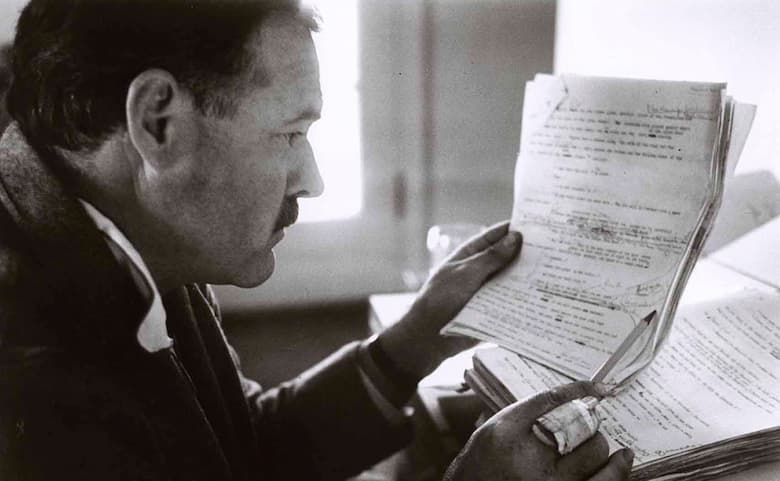
One of the most influential writers of the 20th century, he was known for his direct and understated style and had an intriguing relationship with his writing tools, particularly pencils. His preference for pencils over other writing instruments offers a unique insight into his creative process.
Hemingway's Pencil Ritual
His daily ritual of sharpening dozens of standard lead pencils is well-documented. This routine was more than just a quirky habit; it was an integral part of his approach to writing. Before beginning his work each morning, he would sharpen pencils, ensuring he had enough to last him through the day without interruption. This ritual, in its own way, served as a mental preparation, a transition into his writing zone.
Why Pencils?
For Hemingway, pencils seemed to offer a certain rawness and direct connection to his writing. Unlike pens, which can create a barrier of ink between the writer and the paper, pencils allow for a more tactile experience. The feel of the graphite scratching against the paper, the ability to vary the pressure and thickness of the lines, and even the need to periodically stop and sharpen the pencil, all contributed to a deeply personal and hands-on approach to writing.
The Sensory Experience
The sensory experience of writing with one was likely significant for Hemingway. The sound of it, the feel of the wood, and even the act of sharpening could have been meditative and focusing. For a writer like Hemingway, who was known for his ability to deeply immerse himself in his work, the physical act of writing with one could have helped to anchor him in the creative process.
Pencils and Hemingway's Writing Style
His writing style is famous for its brevity and precision. The use of pencils might have complemented this style. The ability to easily erase and modify text aligns well with his meticulous editing and revising approach. The simplicity of it could have also resonated with his philosophy of writing, which emphasised straightforwardness and clarity over ornateness.
The Symbolism of the Pencil in Hemingway's Work
On a symbolic level, the choice of a pencil could reflect his pursuit of authenticity in his writing. Just as a pencil must be sharpened to reveal a new layer of graphite, Hemingway's writing often delved into uncovering deeper truths about human nature and experience.
Conclusion: The Humble Pencil in the Hands of a Master
His preference for pencils is a fascinating aspect of his larger-than-life persona. It highlights how even the most simple, everyday objects can become powerful tools in the hands of a master. For Hemingway, it was not just a means to an end but a partner in the creative process, a silent witness to the birth of some of the most enduring works of modern literature. In a world increasingly dominated by digital technology, his pencils remind us of the enduring power and beauty of the written word in its most elemental form.
Mark Twain's Love for Fountain Pens
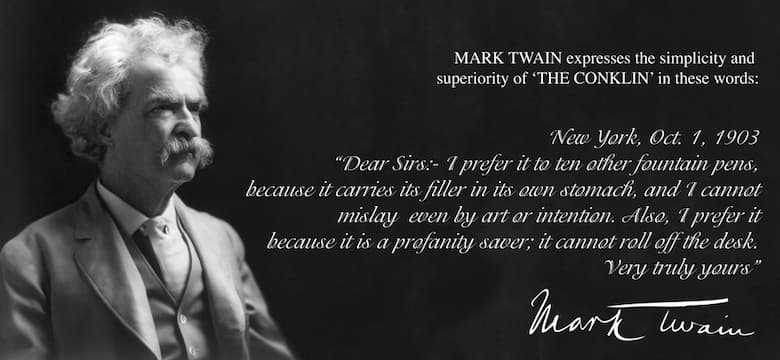
A legendary figure in American literature, renowned for his wit, satire, and keen observation of the human condition, had a particular fondness for fountain pens, notably the Conklin Crescent filler. This preference not only reflected his personal taste but also aligned perfectly with the innovative spirit of his writing.
The Conklin Crescent Filler: A Technological Marvel
At the time he was writing, the Conklin Crescent filler represented a significant advancement in pen technology. Unlike traditional fountain pens requiring frequent refilling and prone to leaks and spills, the Crescent filler was designed for greater reliability and ease of use. Its crescent-shaped filling mechanism, which allowed the ink reservoir to be filled without the need for dipping or unscrewing, was a novel feature that caught Twain's attention.
Why He Loved Fountain Pens
For Twain, the fountain pen, and particularly the Conklin Crescent filler, offered a seamless and uninterrupted writing experience. This was crucial for maintaining his train of thought and narrative flow. The ability to write continuously without stopping to dip the pen in ink was a major advantage, especially for a writer known for his lengthy and complex narratives.
The Impact on Twain's Writing Style
His writing is characterised by its fluidity, humour, and expansive storytelling. The fountain pen's consistent ink flow likely complemented his narrative style, allowing him to transcribe his thoughts onto paper smoothly and without interruption. It also provided a certain elegance and finesse to the handwriting, which might have appealed to Twain's sense of aesthetics.
Twain's Endorsement
His endorsement of the Conklin Crescent filler was a personal preference and a public declaration. He was reportedly so impressed with the pen that he became an official spokesman for the company. This endorsement speaks volumes about the importance he placed on having the right tools for his craft, underscoring the pen's significance in his writing process.
Symbolic Significance
Beyond its practicality, Twain’s embrace of the pen technology can be seen as a reflection of his forward-thinking and innovative nature. Just as his writing often challenged societal norms and pushed boundaries, his choice of writing instrument was ahead of its time, embracing new technologies that enhanced his literary productivity.
Conclusion: A Pen Reflective of the Writer
In essence, his love for the fountain pen is more than a mere historical footnote. It symbolises the synergy between the writer and his tool – a harmony that facilitated the creation of some of the most memorable works in American literature. Twain's use of the fountain pen illustrates how technological advancements can influence and enhance the creative process, a principle as relevant today as it was in his time.
Agatha Christie's Dip Pen Devotion
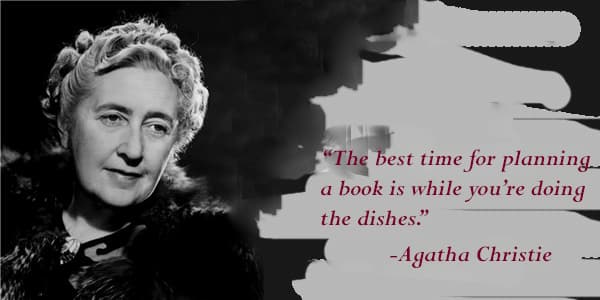
Renowned as the 'Queen of Mystery', she is celebrated for her intricate and captivating detective stories. Interestingly, her writing tool of choice was the traditional dip pen, a choice that speaks volumes about her approach to writing and her connection to the craft.
The Dip Pen in Christie's Writing
The dip pen, a classic writing instrument, consists of a metal nib that is dipped into ink. Unlike modern fountain pens or ballpoints, the dip pen requires frequent re-inking, which can interrupt the flow of writing. For Agatha Christie, however, this was not a hindrance but rather an essential part of her writing ritual.
Why the Dip Pen?
The use of this type of pen necessitates a slower, more deliberate approach to writing. Every few words, the writer must pause to re-ink the pen. This writing and pausing rhythm could have benefitted Christie as she plotted her complex mystery novels. It provided her with moments of reflection and the opportunity to carefully consider each plot twist and character development.
A Connection to the Past
It might also reflect a deeper connection to the past and a certain traditionalism in her approach to writing. In an era where pen technology was rapidly advancing, her choice to stick with a more time-consuming and old-fashioned method indicates a reverence for the historical aspects of writing.
The Ritual of Writing with a Dip Pen
The act of dipping the pen into ink could have been a ritualistic process that helped her transition into her creative mindset. It is more involved than with modern pens, creating a more intimate connection between the writer and their words.
The Impact on Christie's Narrative Style
Her narratives are known for their precision, careful construction, and attention to detail. The dip pen, with its requirement for careful handling and its propensity for a more thoughtful pace, aligns well with these aspects of her writing. Each word and sentence would have been written with a level of consideration that modern, faster writing instruments might not encourage.
Conclusion: The Dip Pen as a Creative Companion
Her devotion to her dip pens was more than just a preference for a writing tool. It was a reflection of her meticulous and methodical approach to crafting her stories. With its traditional charm and deliberate pace, it was a fitting companion for a writer whose works have stood the test of time, captivating readers with their intricate plots and timeless appeal. her choice highlights the deep connection that can exist between a writer and their chosen instrument, a connection that becomes integral to their creative expression.
Virginia Woolf's Fountain Pen Finesse
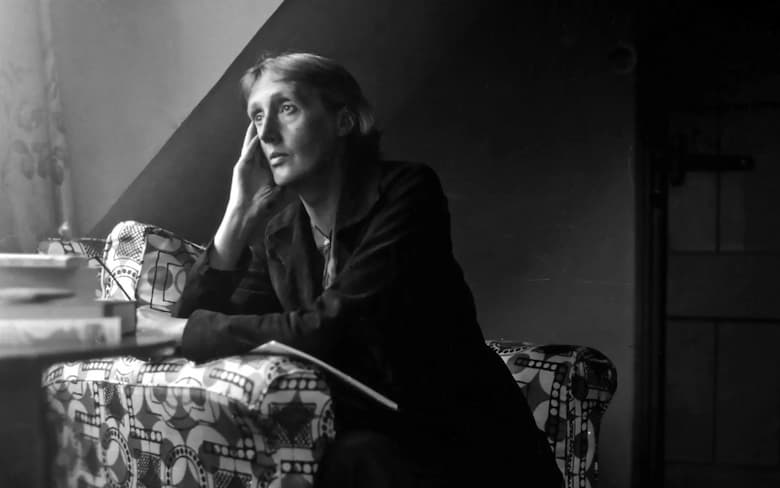
A pioneering figure in modernist literature, she is renowned for her intricate narrative techniques and profound exploration of the human psyche. Her preference for fountain pens during her writing process is not just a trivial detail but a meaningful aspect that aligns closely with her unique literary style.
The Role of Fountain Pens in Woolf's Writing
Fountain pens, known for their smooth ink flow and ease of use, were a natural choice for Woolf, whose writing often involved long, flowing sentences and a stream-of-consciousness approach. This style of writing demands a pen that allows for uninterrupted thought, enabling the writer to capture the intricacies of the mind's workings without pausing.
Why She Chose Fountain Pens
The fluidity offered by them is likely what drew Woolf to them. The continuous flow of ink is conducive to the stream-of-consciousness technique, where thoughts and ideas are presented in a continuous, flowing manner, mimicking the natural thought process. This uninterrupted flow would have been essential for her as she delved into the psychological depths of her characters.
The Sensory Experience of Writing with Them
She was a writer deeply attuned to the sensory experiences of life, and the tactile sensation of a fountain pen gliding over paper could have been significant to her. The physical act of writing with one, where one feels the nib moving fluidly across the page, can create a more intimate and immediate connection with the words being written.
Fountain Pens and Woolf's Narrative Style
Her narrative style is characterised by its lyrical quality and its ability to seamlessly shift between the external world and the internal thoughts of her characters. The seamless ink flow of a fountain pen complements this style, allowing for a more spontaneous and organic development of ideas and descriptions. It's possible that the rhythm and motion of writing played a role in the rhythm and flow of her prose.
The Symbolic Significance
The choice of pen can also be seen as symbolic of her modernist sensibilities. Just as modernist literature broke from traditional narrative forms and explored new ways of expressing thought and emotion, this style of pen represented a break from older writing instruments like the dip pen, offering a new level of freedom and fluidity in writing.
Conclusion: A Harmonious Match
Her preference for fountain pens was more than a mere matter of convenience; it was a choice that harmonised with her innovative and introspective writing style. With its smooth, uninterrupted flow, it was ideally suited to her method of exploring the depths of human consciousness and emotion. It served as an extension of her thoughts, allowing her to translate the complexities of her mind onto paper in a way that few other writing instruments could.
George Orwell's Quill Quest
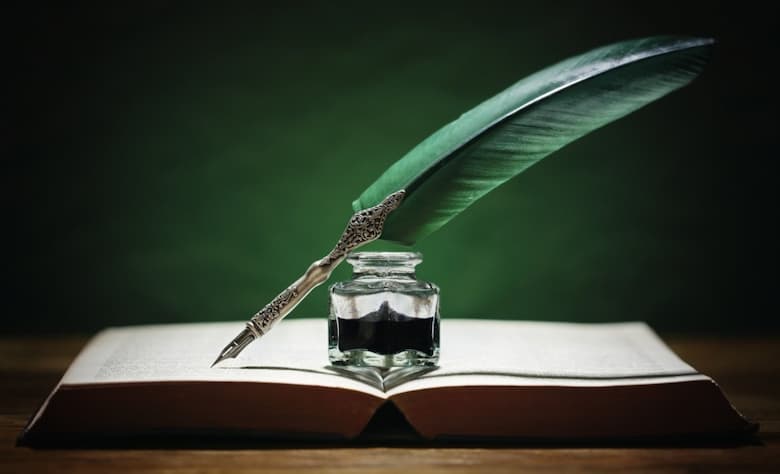
An iconic figure in 20th-century literature, he is known for his incisive social commentaries and dystopian visions, and had a somewhat surprising preference in his writing instrument – the quill pen. This choice is interesting from a historical perspective and offers insight into Orwell's approach to writing and his connection with the broader themes of his work.
The Quill Pen in Orwell's Writing
A traditional writing tool made from a feather (usually a goose or a swan), it has been used for centuries. It requires a certain skill to use effectively, including the regular trimming of the nib and the frequent dipping in ink. For Orwell, a writer deeply engaged with history and tradition, the use of one connected him to the long lineage of writers and thinkers who had influenced him.
Why the Quill for Orwell?
His choice of this style of pen suggests a deliberate connection to the past. In an age when newer writing technologies were available, his preference for the quill indicates a respect for historical writing methods. This choice might have also been symbolic, reflecting his themes that often dealt with the weight of history, tradition, and the passage of time.
The Quill's Impact on Orwell's Writing Style
His writing is characterised by its clarity, conciseness, and forceful argumentation. The quill pen, requiring a more thoughtful and deliberate pace, might have complemented this style. The necessity of frequently re-dipping the pen in ink could have encouraged more contemplation with each word written, aligning with his methodical and precise approach to his prose.
The Sensory and Ritualistic Aspects
The physical act of writing with one involves a certain ritualistic element that could have been appealing to him. It's preparation, the careful dipping of ink, and the tactile sensation of the nib scratching against paper create a deeply sensory and immersive writing experience. For him, this process might have served as a way to engage more deeply with his thoughts and themes.
Symbolic Resonance
It can also be seen as symbolically resonant with his themes of timelessness and the enduring nature of societal issues. Much like the quill pen has a timeless quality, Orwell's works, such as "1984" and "Animal Farm," explore themes that are perpetually relevant, transcending the specific historical contexts in which they were written.
Conclusion: The Quill's Timeless Connection
His use of a quill pen was more than just a personal preference; it was a choice that connected him to the historical tradition of writing and mirrored the timeless nature of his literary themes. Its historical significance and unique writing experience was a fitting instrument for a writer whose works continue to resonate with readers for their insight into human nature and societal structures.
The Wrap Up
So, there you have it, folks! It's truly remarkable how each of these literary legends had unique preferences regarding their writing instruments. Whether it's the humble ballpoint or the classic fountain pen, it’s clear that the pen is not just a tool but a companion in the artistic journey of a writer.
What about you? Do you have a favourite writing tool that helps you channel your inner creativity? Remember, it's not about the pen you use, but the stories you tell and the worlds you create with it. Keep writing and keep inspiring!
The Printed Pens Team

